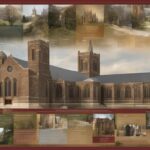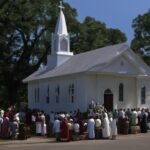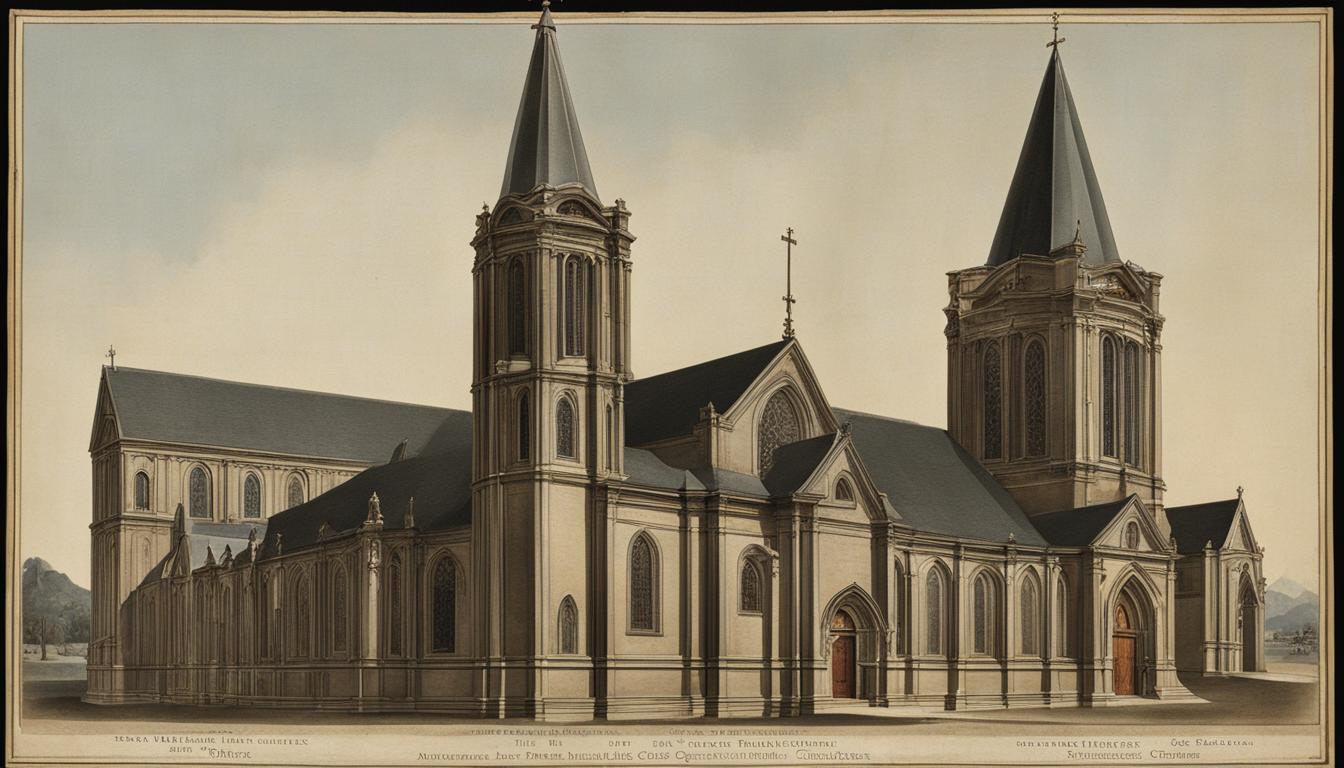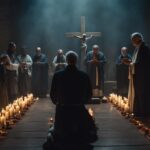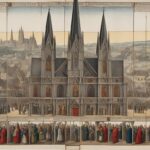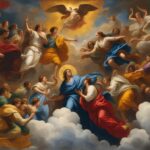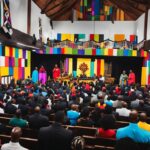The history of the Catholic Church is a testament to the enduring power of faith and the resilience of a global community. Spanning nearly two thousand years, the Catholic Church has witnessed pivotal moments in world history, shaping the course of Christianity and impacting countless lives along the way.
The origins of the Catholic Church can be traced back to the ministry of Jesus Christ and the early Christian community formed by his disciples. From those humble beginnings, the Catholic Church grew into the world’s oldest continuously functioning international institution, leaving an indelible mark on the spiritual, cultural, and social fabric of humanity.
Throughout its history, the Catholic Church has navigated challenges and transformations, adapting to the ever-changing world while upholding its core beliefs and doctrines. It is characterized by its reverence for sacred texts, its sacraments and rituals that provide a tangible connection to God’s grace, and its steadfast leadership and clergy who guide the faithful.
Worship practices within the Catholic Church are marked by a sense of reverence and devotion. The celebration of the Mass, with its prayers, readings, and the Eucharistic celebration, forms the heart of Catholic worship. The liturgical year, punctuated by seasons like Advent, Lent, Easter, and Christmas, adds depth and meaning to the spiritual journey of believers.
The Catholic Church recognizes the Bible as its sacred text, drawing inspiration and guidance from its teachings. The beliefs and doctrines of the Church, including the Trinity, the divinity of Jesus Christ, and the authority of the Pope, shape the spiritual lives of its followers.
While the Catholic Church is the largest branch of Christianity, it is not a monolithic entity. Different denominations and sects within Catholicism, such as the Eastern Catholic Churches and traditionalist groups, highlight the diversity of practices and interpretations that coexist within the larger Catholic framework.
Community and outreach are fundamental pillars of the Catholic Church. From acts of charity and social justice to the provision of education and healthcare, the Church plays an active role in serving its local communities and the broader global community.
In addition to its spiritual and social contributions, the Catholic Church is renowned for its architectural and artistic splendor. Grand cathedrals, basilicas, and churches adorned with magnificent artwork and intricate sculptures inspire awe and elevate the act of worship.
While the Catholic Church has a rich history, it also faces contemporary issues and challenges. Discussions on topics like contraception, women’s ordination, and addressing cases of sexual abuse continue to shape the Church’s path forward. Despite these challenges, the Catholic Church remains steadfast in its mission to spread the message of love, compassion, and faith.
Key Takeaways:
- The Catholic Church has a rich and intricate history spanning nearly two thousand years.
- It traces its origins back to the ministry of Jesus Christ and the early Christian community.
- Catholicism is characterized by its beliefs, sacraments, leadership, worship practices, and reverence for sacred texts.
- There are different denominations and sects within Catholicism that share a common belief but have distinct practices.
- The Catholic Church places a strong emphasis on community, outreach, and charitable works.
Origins and Early Christianity
The origins of the Catholic Church can be traced back to the ministry of Jesus Christ and the early Christian community formed by his disciples. Simon Peter, one of Jesus’ twelve apostles, played a crucial role in the early church, followed by James, Jesus’ brother.
“You are Peter, and on this rock, I will build my church.”
This quote from Jesus highlights the foundational role of Peter in the establishment of the Catholic Church. The early Christians initially viewed themselves as a reform movement within Judaism, but as the movement grew, divisions emerged, including Pauline Christianity and Gnostic Christianity.
Pauline Christianity emphasized the teachings of the apostle Paul, who played a significant role in spreading Christianity to the Gentiles. His letters became integral to the development of Christian theology.
Gnostic Christianity focused on mystical and esoteric knowledge, believing in the existence of a secret spiritual understanding that granted salvation.
These different branches of early Christianity shaped the development of the Catholic Church and laid the foundation for its beliefs and practices.
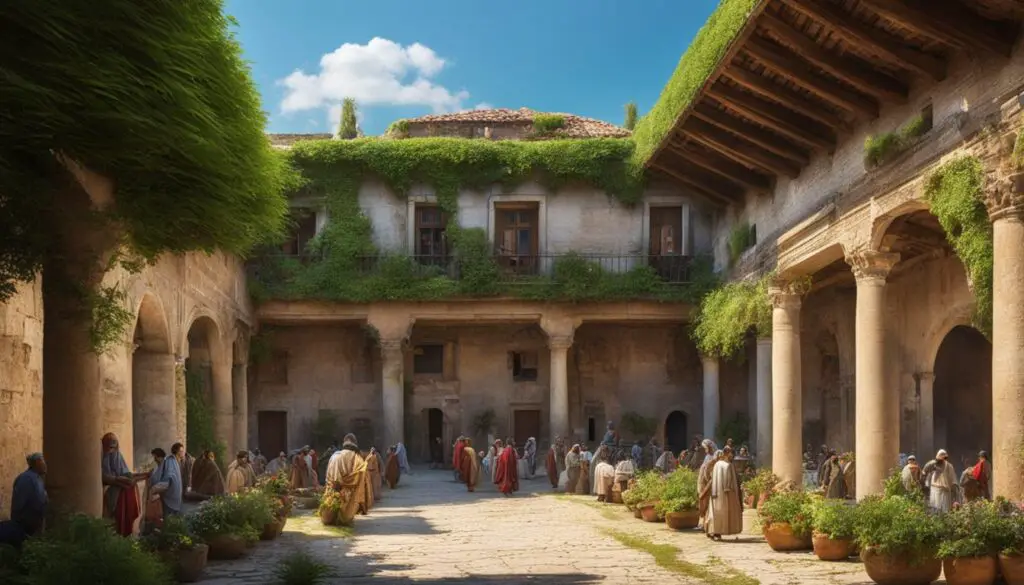
| Origins of the Catholic Church | Early Christianity |
|---|---|
| The ministry of Jesus Christ | Reform movement within Judaism |
| Role of Simon Peter and James | Emergence of divisions: Pauline and Gnostic Christianity |
Beliefs and Doctrines
Catholicism is a faith deeply rooted in its beliefs and doctrines, which are derived from the teachings of Jesus Christ and the interpretation of Scripture by the Church. These teachings form the foundation of the Catholic Church and are imparted to its followers as essential truths for spiritual growth and salvation.
At the core of Catholic beliefs is the belief in the Holy Trinity, which holds that God exists as three distinct persons: the Father, the Son (Jesus Christ), and the Holy Spirit. This concept underscores the idea of God’s Triune nature and His presence in all aspects of human life.
An integral aspect of Catholic teachings is the affirmation of the divinity of Jesus Christ. Catholics believe that Jesus is the Son of God who took on human form to redeem humanity from sin. The incarnation, crucifixion, and resurrection of Jesus are fundamental events in Catholic theology, underscoring the importance of Christ’s sacrifice for the salvation of all mankind.
The Catholic Church is also defined by its hierarchical structure and the authority of the Pope as the head of the Church. Catholics believe that the Pope is the successor of St. Peter, appointed by Jesus himself. The Pope is regarded as the Vicar of Christ on Earth and is believed to possess the spiritual authority to guide and lead the faithful.
Sacraments play a vital role in Catholicism and are seen as visible signs of God’s grace. Catholics believe in the importance of participating in the sacraments to strengthen their relationship with God and receive His sanctifying grace. The most significant sacraments are baptism, which initiates individuals into the Church, and the Eucharist, which Catholics believe is the real presence of Jesus Christ in the form of bread and wine.
“The sacraments are a source of spiritual nourishment and a means for believers to encounter the divine. They serve as transformative moments in the lives of Catholics, fostering spiritual growth and deepening their faith.”

Catholic teachings encompass a broad range of moral and ethical principles that guide the actions and decisions of believers. These teachings center around the concepts of love, mercy, forgiveness, and social justice, emphasizing the importance of living a virtuous life and extending compassion to others.
Central to Catholic beliefs and doctrines is the recognition of the authority of the Church and its role as the custodian and interpreter of Scripture. The Catholic Church holds the Bible as a sacred text and believes that its teachings must be properly understood within the context of tradition and the guidance of the Magisterium, which is the teaching authority of the Church.
Overall, Catholic beliefs and doctrines provide a foundation for spiritual growth, moral guidance, and a deep connection to God. They serve as a compass in the lives of believers, offering a path to salvation and eternal communion with the divine.
Sacraments and Rituals
The Catholic Church places great importance on sacraments, which are visible signs of God’s grace. These sacred rituals hold profound meaning for Catholic believers, allowing them to experience the presence of God and receive His blessings directly.
The Seven Sacraments
Central to the Catholic faith are the seven sacraments, each with its own unique significance:
- Baptism: The sacrament of initiation, through which a person becomes a member of the Church and receives the gift of the Holy Spirit.
- Confirmation: The sacrament that strengthens and deepens the grace received at baptism, equipping individuals with the gifts of the Holy Spirit.
- Eucharist: Also known as the Holy Communion, this sacrament marks the body and blood of Jesus Christ, which Catholics believe to be truly present in the consecrated host and wine.
- Reconciliation: Through confession and absolution, this sacrament provides Catholics with spiritual healing and forgiveness for sins committed after baptism.
- Anointing of the Sick: This sacrament offers strength and healing to those who are facing serious illness or the challenges of old age.
- Matrimony: The sacrament of marriage, which symbolizes the unbreakable bond between a man and a woman, reflecting the love of Christ for His Church.
- Holy Orders: This sacrament confers the authority and responsibility of the priesthood, allowing ordained men to serve as spiritual leaders and administer the other sacraments.
Each sacrament is accompanied by specific ritual practices, which enhance the spiritual experience and foster a deeper connection with God.
Example: The Sacrament of Confession
One sacrament that holds significant importance in the Catholic Church is the sacrament of confession, also known as the sacrament of reconciliation or penance. It is a deeply personal and intimate encounter with God’s mercy, allowing believers to seek forgiveness for their sins and experience spiritual healing.
“The greater the sinner, the greater the right he has to My mercy.”
During the sacrament of confession, an individual confesses their sins to a priest, who acts as a representative of Christ and offers guidance and absolution. This sacramental encounter provides a safe space for believers to reflect on their actions, seek forgiveness, and receive spiritual counsel for personal growth.
Lorem ipsum dolor sit amet, consectetur adipiscing elit. Phasellus dictum varius lectus, a malesuada tellus aliquet in. Curabitur eget porttitor nisi. Ut convallis turpis sed finibus auctor. Aliquam vel fringilla augue.
Etiam varius magna nec metus auctor, ut malesuada ante volutpat. Vestibulum ante ipsum primis in faucibus orci luctus et ultrices posuere cubilia curae; Morbi fringilla auctor dapibus. Nulla nec sem eu quam porttitor faucibus vitae ut dolor. Fusce scelerisque eu sem non volutpat.
Pellentesque consequat, felis sed dictum luctus, odio augue sodales lacus, sed consequat urna enim non ipsum. Maecenas vel suscipit magna. Curabitur sed diam ligula. Nunc finibus ut augue eget lobortis. Praesent euismod fringilla urna.
Leadership and Clergy
The Catholic Church operates under a defined hierarchical structure, with the Pope serving as its supreme leader. As the successor of St. Peter, the Pope exerts authority over the entire Church, guiding its teachings and practices. Below the Pope, bishops are responsible for overseeing individual dioceses, ensuring that the spiritual needs of the faithful are met. Priests, on the other hand, serve as spiritual leaders within parishes, providing guidance, support, and sacraments to the Catholic community.
Additionally, the Catholic Church is home to various orders of religious clergy, such as monks and nuns. These dedicated individuals pursue a life of service and devotion, striving to live out their religious vows and contribute to the spiritual well-being of the Church.

Their commitment to the Catholic faith and their tireless efforts in fostering the spiritual growth of the faithful are integral to the functioning and vitality of the Catholic Church.
Worship Practices
In the Catholic Church, worship is centered around the celebration of the Mass, which is the pinnacle of Catholic worship practices. During the Mass, Catholics come together as a community to offer praise, thanksgiving, and adoration to God.
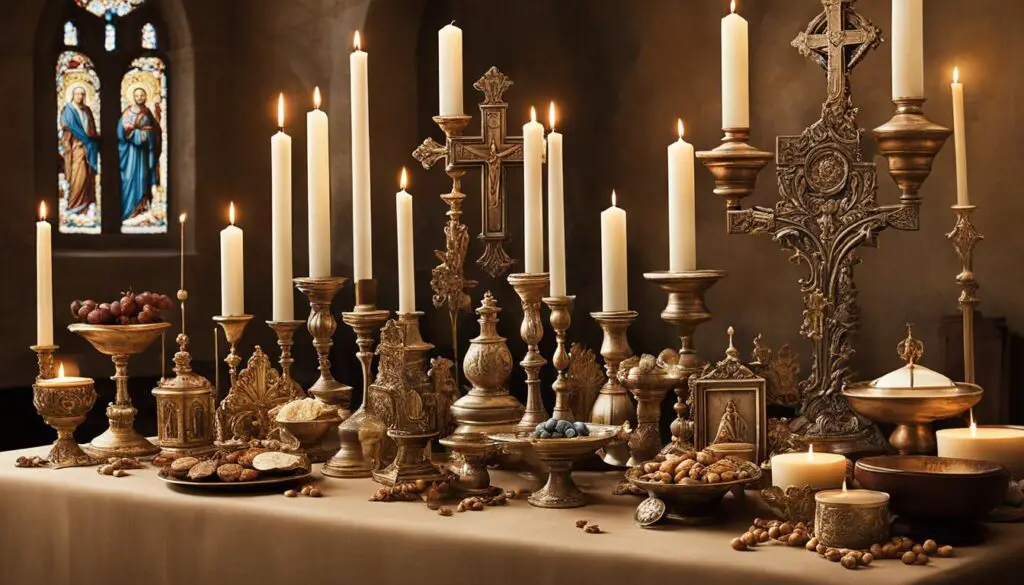
The Mass is a sacred ceremony that includes various elements, such as prayers, readings from the Bible, homilies, and the Eucharistic celebration. Through these components, Catholics engage in a profound encounter with God and receive His grace.
“The Eucharist is the source and summit of the Christian life.” – Catechism of the Catholic Church
In addition to the Mass, Catholics also participate in various devotional practices that enhance their personal relationship with God. These practices include praying the rosary, a meditative prayer that focuses on the life of Jesus and the Virgin Mary, as well as adoration of the Blessed Sacrament, where believers spend time in the presence of the consecrated host, believing it to be the true Body of Christ.
Personal prayer is another essential aspect of Catholic worship. Through individual prayer, Catholics can offer their intentions, seek guidance, and deepen their spiritual connection with God.
Sacred Liturgical Year
The liturgical year is an integral part of Catholic worship. It follows a cycle of seasons, each with its own significance and focus. These seasons include Advent, a time of preparation and anticipation for the birth of Jesus; Lent, a season of reflection, penance, and preparation for Easter; Easter, a season of joy and celebration of Jesus’ resurrection; and Christmas, a season that commemorates the birth of Jesus.
Each season of the liturgical year is accompanied by specific prayers, rituals, and traditions, which enrich the worship experience and deepen the spiritual journey of Catholics.
Catholic Worship Practices
| Practice | Description |
|---|---|
| Mass | The central act of Catholic worship, involving prayers, readings, homilies, and the Eucharistic celebration. |
| Rosary | A meditative prayer consisting of repeating prayers and reflecting on the life of Jesus and the Virgin Mary. |
| Adoration of the Blessed Sacrament | Spending time in the presence of the consecrated host, believing it to be the true Body of Christ. |
| Personal Prayer | Individual communication with God, offering intentions, seeking guidance, and deepening the spiritual connection. |
Catholic worship practices encompass a rich tapestry of rituals, traditions, and spiritual experiences that foster a deep sense of faith and devotion among believers.
Sacred Texts
The Catholic Church reveres the Bible as its sacred text, encompassing both the Old Testament and the New Testament. Believed to be divinely inspired by God, the Bible serves as the ultimate guide for Catholic faith and practice. It contains the teachings, narratives, and wisdom that shape the Catholic worldview.
Within the Bible, the Old Testament holds profound significance, as it captures the history, stories, prophecies, and laws of the Hebrew people before the birth of Jesus Christ. It contains revered texts such as Genesis, Exodus, Psalms, and Proverbs.
The New Testament, on the other hand, focuses on the life, teachings, death, and resurrection of Jesus Christ and the early Christian community. It includes the Gospel accounts of Matthew, Mark, Luke, and John, as well as the epistles or letters written by the apostles like Paul, Peter, and John.
In addition to the Bible, the Catholic Church places value in other sacred texts, such as the Catechism of the Catholic Church. This comprehensive document provides a systematic and authoritative summary of Catholic doctrine, teachings, and moral principles. It serves as a valuable resource for understanding the tenets of the faith and applying them to daily life.
“The sacred texts of the Catholic Church are not mere words on a page; they are a source of wisdom, revelation, and guidance for the faithful.”
The Catholic Church encourages its followers to engage with these sacred texts through prayer, study, and reflection. By immersing themselves in the Scriptures, Catholics seek to deepen their relationship with God and align their lives with His teachings.
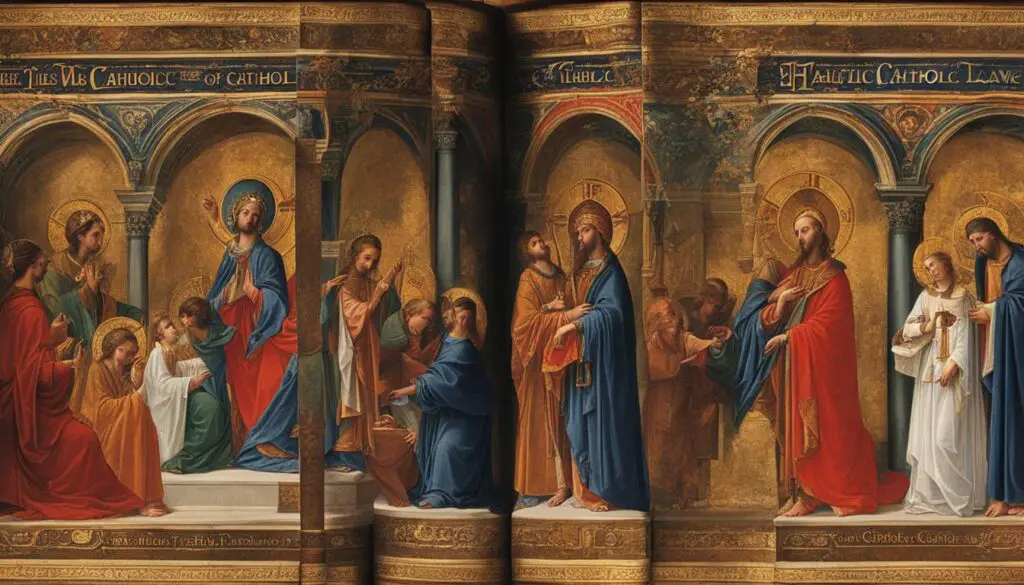
| Text | Description |
|---|---|
| Bible | The sacred scripture of Christianity, comprising the Old Testament and the New Testament. |
| Catechism of the Catholic Church | An official compendium that presents the essential teachings and beliefs of the Catholic faith. |
Denominations and Sects
While the Catholic Church is the largest branch of Christianity, it is important to note that within Catholicism, there exist various denominations and sects. These groups demonstrate variations in practices and interpretations, while still sharing a common belief in the authority of the Pope and the fundamental teachings of the Catholic Church.
One such example is the Eastern Catholic Churches, which have their own distinct traditions and practices. These churches, located primarily in Eastern Europe and the Middle East, maintain communion with Rome but celebrate liturgies in their respective Eastern rites. The Eastern Catholic Churches add cultural richness and diversity to the universal Catholic Church.
Another subgroup within Catholicism is the traditionalist groups that reject certain changes implemented by the Second Vatican Council in the 1960s. These groups advocate for a return to pre-Vatican II traditions and practices, emphasizing the Latin Mass and conserving traditional liturgy.
“The diversity within Catholic denominations and sects enriches the overall tapestry of Catholicism while reinforcing the central teachings of the faith.” – Pope Francis
Despite these differences, it is vital to recognize that all Catholic denominations and sects share a commitment to the core beliefs of the Catholic Church. This includes a reverence for the Pope as the head of the Church, the importance of the sacraments, and the teachings passed down through apostolic tradition.
The variety within Catholic denominations and sects serves to promote dialogue, encourage cultural exchange, and foster a deeper understanding of the universal Catholic faith.
| Denomination or Sect | Main Characteristics |
|---|---|
| Eastern Catholic Churches | Distinct liturgical traditions, such as the Byzantine, Coptic, and Maronite rites |
| Traditionalist Groups | Advocacy for pre-Vatican II practices, emphasis on Latin Mass and traditional liturgy |
| Other Independent Catholic Churches | Autonomous Catholic churches not in full communion with Rome |
Community and Outreach
The Catholic Church places a strong emphasis on building a vibrant and inclusive community that fosters love, support, and connection among its members. The sense of belonging to a close-knit Catholic community is a fundamental aspect of the Catholic faith. Through active participation in parish life, Catholics come together to worship, share their faith, and engage in fellowship.
One of the core principles of the Catholic Church is the call to serve those in need and promote social justice. Through acts of charity and outreach, Catholics strive to demonstrate God’s love to the world and make a positive impact on their local communities. Whether it is feeding the hungry, sheltering the homeless, or providing healthcare services to the underserved, the Catholic Church is committed to addressing the needs of the most vulnerable members of society.
Furthermore, the Catholic Church’s outreach extends beyond its immediate community. Through various charitable organizations and initiatives, the Catholic Church plays a significant role in education, healthcare, and humanitarian efforts worldwide. Catholic schools offer quality education rooted in Catholic values, while Catholic hospitals and clinics provide vital healthcare services to people of all faiths. Additionally, the Catholic Church actively supports numerous humanitarian projects focused on poverty alleviation, disaster relief, and sustainable development.
The Catholic Church believes that by practicing acts of charity, kindness, and compassion, individuals can bring the light of Christ to others and contribute to the well-being of society as a whole. Engaging in community and outreach activities allows Catholics to live out their faith in tangible ways and be a positive force for change in the world.
Quotes:
“We are not made for isolation; we are made for community. In the Catholic Church, we find a family, a place where we can connect with others, share our joys and sorrows, and grow together in faith and love.” – Archbishop John Smith
Community and Outreach in Action:
| Initiative | Description |
|---|---|
| Catholic Charities | An organization that provides a wide range of social services, including food assistance, housing support, counseling, and refugee resettlement. |
| Caritas Internationalis | A global network of Catholic charities that works to alleviate poverty and promote social justice around the world through various development projects and emergency response efforts. |
| Missionaries of Charity | An order founded by Mother Teresa that serves the poorest of the poor, caring for and comforting those who are marginalized and forgotten. |
Architectural and Artistic Features
Catholicism embraces a rich tradition of architectural and artistic expression, resulting in awe-inspiring structures and exquisite artwork within its churches and cathedrals. These architectural and artistic features serve as visual representations of the faith, inspiring worshipers and reflecting the divine glory.
Grand Cathedrals, Basilicas, and Churches
The Catholic Church is renowned for its magnificent grand cathedrals, basilicas, and churches. These architectural marvels showcase intricate details and elaborate designs that leave visitors in awe. From the imposing Gothic cathedrals with their soaring spires and intricate stained glass windows to the majestic Renaissance-inspired basilicas adorned with ornate frescoes and sculptures, these structures transport believers to a realm of divine beauty and spiritual contemplation.
| Architectural Features | Artistic Features |
|---|---|
| Gothic architecture with pointed arches and ribbed vaults | Stained glass windows depicting biblical scenes and saints |
| Baroque and Rococo embellishments with ornate sculptures and marble accents | Frescoes and religious paintings by renowned artists |
| Neoclassical facades with elegant columns and pediments | Sculptures and reliefs depicting religious symbolism |
Intricate Sculptures and Artwork
Within these Catholic establishments, intricate sculptures and artwork adorn the interior spaces. Skilled artisans have painstakingly created sculptures depicting biblical figures, saints, and religious scenes, evoking a sense of reverence and devotion. These masterpieces of artistry invite worshipers to contemplate the sacred stories they represent and connect with their spiritual significance.
“The purpose of Catholic art is to raise the mind and heart to God, allowing believers to experience the divine through beauty and aesthetics.” – Pope Francis
Contemporary Issues and Challenges
The Catholic Church, like any longstanding institution, faces various contemporary issues and challenges in the modern world. As society evolves, so do the conversations surrounding certain topics that intersect with Catholic teachings and traditions. These discussions serve as opportunities for dialogue and reflection, highlighting the ongoing relevance of Catholicism today.
Contraception and Family Planning
One of the challenges the Catholic Church grapples with is the issue of contraception and family planning. The Church views human life as sacred from conception to natural death, and therefore teaches that the use of artificial birth control is morally wrong. This stance has sparked debates and conversations surrounding individual autonomy, reproductive rights, and the changing dynamics of family structures in contemporary society.
Women’s Ordination
Another significant issue is the question of women’s ordination within the Catholic Church. Currently, the Church reserves the priesthood exclusively for men, citing theological and historical reasons for this tradition. However, there are ongoing discussions within the Church about the potential inclusion of women in ordained ministries, addressing considerations of gender equality and the evolving role of women in society.
Same-Sex Marriage
The topic of same-sex marriage is another contemporary issue that challenges the Catholic Church’s teachings. The Church holds a traditional understanding of marriage as a sacramental union between a man and a woman. As societal attitudes and legal frameworks evolve to recognize same-sex relationships, the Church faces the challenge of reconciling its teachings with changing cultural norms and ensuring inclusivity while upholding its moral and theological convictions.
Addressing Sexual Abuse
The ongoing challenge of addressing cases of sexual abuse within the Catholic Church is another pressing issue. The church has faced criticism and legal challenges regarding its handling of allegations and the protection of survivors. This issue has prompted a reassessment of policies, a commitment to transparency, and efforts to provide support and justice for victims. The Catholic Church continues to prioritize the protection and healing of survivors while working towards preventing further abuse.
“The Catholic Church faces contemporary challenges with a commitment to upholding its teachings while engaging in meaningful dialogue and reflection.”
These contemporary issues and challenges demonstrate the complex nature of Catholicism in today’s world. While the Church must navigate these discussions and challenges, it remains rooted in its core teachings and traditions, seeking to promote dialogue, understanding, and spiritual growth.
Conclusion
The history and journey of the Catholic Church are a testament to the enduring power of faith and tradition. From its humble apostolic origins to its global presence today, the Catholic Church has weathered challenges and embraced transformations, leaving an indelible mark on the world. Throughout the centuries, the Church has served as a source of inspiration, guidance, and solace for millions of believers, nurturing their spiritual growth and fostering a deep connection with God.
At the core of the Catholic Church’s teachings are its beliefs and doctrines, which are rooted in the life and teachings of Jesus Christ. The sacred sacraments and rituals provide tangible means for believers to experience God’s grace and presence in their lives. Guided by the leadership of the Pope, bishops, priests, and religious clergy, the Church upholds its rich liturgical traditions, fostering a sense of unity and spiritual nourishment among its followers.
The Catholic Church’s commitment to community and outreach is exemplified through its dedication to social justice, acts of charity, and global humanitarian efforts. Believers are encouraged to actively participate in their local parishes, cultivating a sense of belonging and contributing to the well-being of their communities. The Church also cherishes its artistic and architectural heritage, with breathtaking cathedrals and artwork serving as powerful expressions of faith and sources of inspiration for worshipers.
While the Catholic Church faces challenges and contemporary issues in an ever-changing world, its commitment to upholding its teachings remains steadfast. The Church continues to engage in thoughtful discussions and navigate complex topics, striving to uphold its principles while embracing compassion and understanding. With an eye toward the future, the Catholic Church stands as a testament to the enduring power of faith, tradition, and love.
FAQ
What is the history of the Catholic Church?
The history of the Catholic Church spans nearly two thousand years, making it the world’s oldest continuously functioning international institution.
What are the origins of the Catholic Church?
The Catholic Church can be traced back to the ministry of Jesus Christ and the early Christian community formed by his disciples.
What are the beliefs and doctrines of the Catholic Church?
The Catholic Church is characterized by its beliefs in the Trinity, the divinity of Jesus Christ, the authority of the Pope, and the importance of sacraments.
What are the sacraments and rituals of the Catholic Church?
The Catholic Church recognizes seven sacraments, including baptism, confirmation, Eucharist, reconciliation, anointing of the sick, matrimony, and holy orders.
Who are the leaders and clergy in the Catholic Church?
The Catholic Church has a hierarchical structure with the Pope as the supreme leader. Below the Pope are bishops, priests, and various orders of religious clergy.
What are the worship practices of the Catholic Church?
The central act of worship for Catholics is the celebration of the Mass. Catholics also participate in devotional practices and follow the liturgical year.
What are the sacred texts of the Catholic Church?
The Catholic Church recognizes the Bible as its sacred text, which includes the Old and New Testaments. The Catechism of the Catholic Church is also valued as a comprehensive summary of Catholic doctrine.
What are the denominations and sects within the Catholic Church?
While the Catholic Church is the largest branch of Christianity, there are other denominations and sects within Catholicism, including Eastern Catholic Churches and traditionalist groups.
How does the Catholic Church engage in community and outreach?
The Catholic Church encourages participation in parish life, acts of charity and social justice, and involvement in education, healthcare, and humanitarian efforts.
What are the architectural and artistic features of the Catholic Church?
The Catholic Church has a rich tradition of architectural and artistic expression, evident in grand cathedrals, basilicas, and churches adorned with stunning artwork and sculptures.
What contemporary issues and challenges does the Catholic Church face?
The Catholic Church faces various issues and challenges, including discussions on contraception, women’s ordination, same-sex marriage, and addressing cases of sexual abuse.
What is the conclusion about the Catholic Church?
The Catholic Church has a profound history and continues to be a beacon of faith, tradition, and devotion for millions of believers worldwide.

